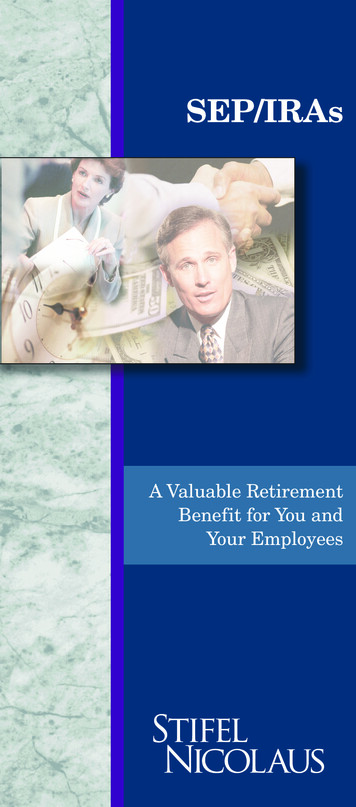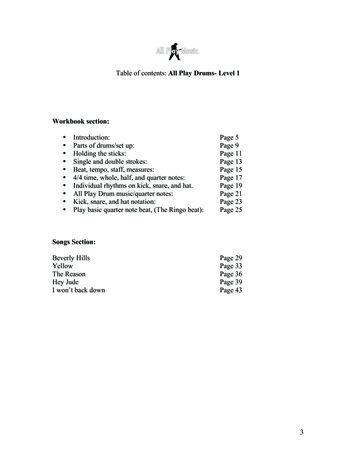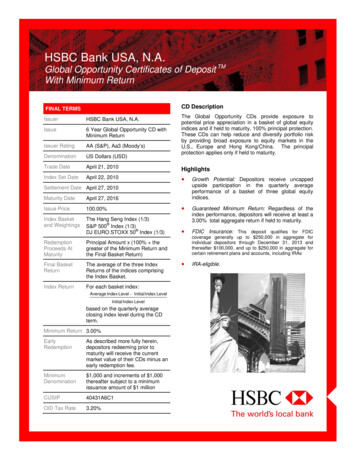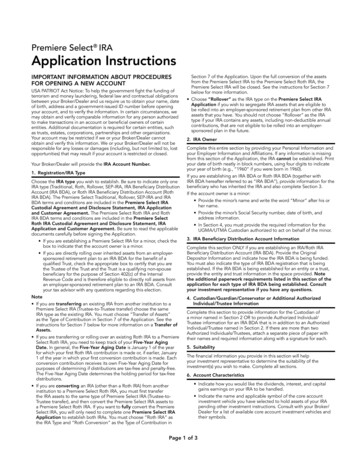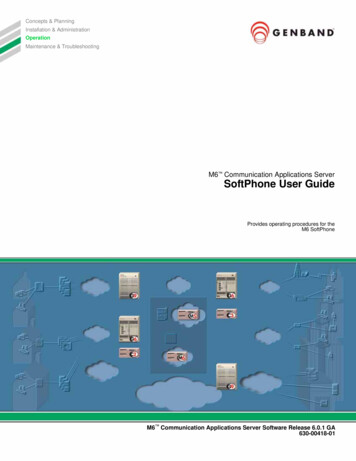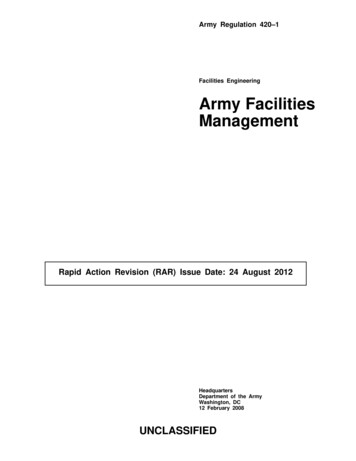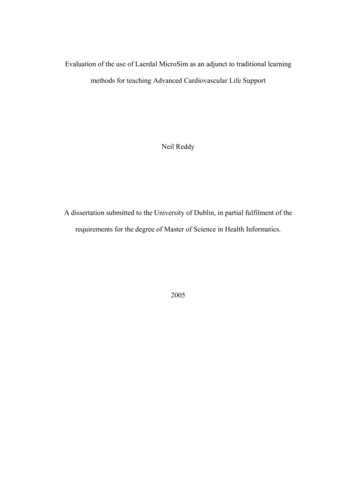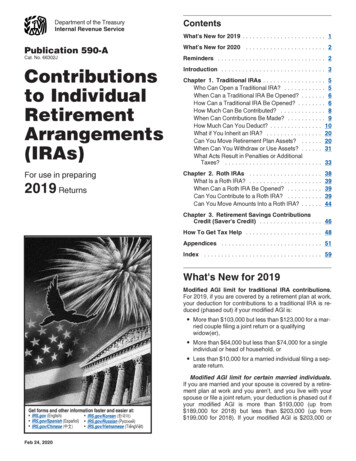
Transcription
Department of the TreasuryInternal Revenue ServicePublication 590-AContentsWhat's New for 2019 . . . . . . . . . . . . . . . . . . . . . . . . 1What’s New for 2020 . . . . . . . . . . . . . . . . . . . . . . . 2Cat. No. 66302JReminders . . . . . . . . . . . . . . . . . . . . . . . . . . . . . . . 2Contributionsto IndividualRetirementArrangements(IRAs)Introduction . . . . . . . . . . . . . . . . . . . . . . . . . . . . . . 3For use in preparing2019 ReturnsChapter 1. Traditional IRAs . . . . . . . . . . . .Who Can Open a Traditional IRA? . . . . . .When Can a Traditional IRA Be Opened? .How Can a Traditional IRA Be Opened? . .How Much Can Be Contributed? . . . . . . .When Can Contributions Be Made? . . . . .How Much Can You Deduct? . . . . . . . . . .What if You Inherit an IRA? . . . . . . . . . . .Can You Move Retirement Plan Assets? .When Can You Withdraw or Use Assets? .What Acts Result in Penalties or AdditionalTaxes? . . . . . . . . . . . . . . . . . . . . . . .Chapter 2. Roth IRAs . . . . . . . . . . . . . . .What Is a Roth IRA? . . . . . . . . . . . . . . .When Can a Roth IRA Be Opened? . . . .Can You Contribute to a Roth IRA? . . . .Can You Move Amounts Into a Roth IRA?.55668910202031. . . . . 33.3839393944Chapter 3. Retirement Savings ContributionsCredit (Saver's Credit) . . . . . . . . . . . . . . . . . . 46How To Get Tax Help . . . . . . . . . . . . . . . . . . . . . . 48Appendices . . . . . . . . . . . . . . . . . . . . . . . . . . . . . 51Index . . . . . . . . . . . . . . . . . . . . . . . . . . . . . . . . . . 59What's New for 2019Modified AGI limit for traditional IRA contributions.For 2019, if you are covered by a retirement plan at work,your deduction for contributions to a traditional IRA is reduced (phased out) if your modified AGI is: More than 103,000 but less than 123,000 for a married couple filing a joint return or a qualifyingwidow(er), More than 64,000 but less than 74,000 for a singleindividual or head of household, or Less than 10,000 for a married individual filing a separate return.Get forms and other information faster and easier at: IRS.gov (English) IRS.gov/Spanish (Español) IRS.gov/Chinese (中文)Feb 24, 2020 IRS.gov/Korean (한국어) IRS.gov/Russian (Pусский) IRS.gov/Vietnamese (TiếngViệt)Modified AGI limit for certain married individuals.If you are married and your spouse is covered by a retirement plan at work and you aren’t, and you live with yourspouse or file a joint return, your deduction is phased out ifyour modified AGI is more than 193,000 (up from 189,000 for 2018) but less than 203,000 (up from 199,000 for 2018). If your modified AGI is 203,000 or
more, you can’t take a deduction for contributions to a traditional IRA.Modified AGI limit for Roth IRA contributions. For2019, your Roth IRA contribution limit is reduced (phasedout) in the following situations. Your filing status is married filing jointly or qualifyingwidow(er) and your modified AGI is at least 193,000.You can’t make a Roth IRA contribution if your modified AGI is 203,000 or more. Your filing status is single, head of household, or married filing separately and you didn’t live with yourspouse at any time in 2019 and your modified AGI isat least 122,000. You can’t make a Roth IRA contribution if your modified AGI is 137,000 or more. Your filing status is married filing separately, you livedwith your spouse at any time during the year, and yourmodified AGI is more than zero. You can’t make aRoth IRA contribution if your modified AGI is 10,000or more.Difficulty of care payments. You may be able to makeadditional nondeductible IRA contributions after December 20, 2019, if you received difficulty of care payments,which are a type of qualified foster care payment. Formore information, see Difficulty of care payments, later.Repeal of alimony payments as inclusion in compensation. Alimony received is not included in your compensation if a divorce or separation agreement is entered intoafter December 31, 2018, or if you entered into a divorceor separation agreement on or before December 31,2018, and the agreement is changed after December 31,2018, to expressly provide that alimony received isn't included in your income. For more information, see Pub.504.What’s New for 2020Modified AGI limit for traditional IRA contributions increased. For 2020, if you are covered by a retirementplan at work, your deduction for contributions to a traditional IRA is reduced (phased out) if your modified AGI is: More than 104,000 but less than 124,000 for a married couple filing a joint return or a qualifyingwidow(er), More than 65,000 but less than 75,000 for a singleindividual or head of household, or Less than 10,000 for a married individual filing a separate return.Modified AGI limit for certain married individualsincreased. If you are married and your spouse is covered by a retirement plan at work and you aren’t, and youlive with your spouse or file a joint return, your deductionis phased out if your modified AGI is more than 196,000(up from 193,000 for 2019) but less than 206,000 (upfrom 203,000 for 2019). If your modified AGI is 206,000or more, you can’t take a deduction for contributions to atraditional IRA.Page 2Modified AGI limit for Roth IRA contributions increased. For 2020, your Roth IRA contribution limit is reduced (phased out) in the following situations. Your filing status is married filing jointly or qualifyingwidow(er) and your modified AGI is at least 196,000.You can’t make a Roth IRA contribution if your modified AGI is 206,000 or more. Your filing status is single, head of household, or married filing separately and you didn’t live with yourspouse at any time in 2020 and your modified AGI isat least 124,000. You can’t make a Roth IRA contribution if your modified AGI is 139,000 or more. Your filing status is married filing separately, you livedwith your spouse at any time during the year, and yourmodified AGI is more than zero. You can’t make aRoth IRA contribution if your modified AGI is 10,000or more.Certain taxable non-tuition fellowship and stipends.For tax years beginning after December 31, 2019, certaintaxable non-tuition fellowship and stipend payments aretreated as compensation for the purpose of IRA contributions. Compensation will include any amount included inyour gross income and paid to aid in your pursuit of graduate or postdoctoral study.Maximum age for making traditional IRA contributions repealed. For tax years beginning after December31, 2019, the rule that you are not able to make contributions to your traditional IRA for the year in which you reachage 70 1/2 and all later years has been repealed.Required minimum distributions (RMDs). For distributions required to be made after December 31, 2019, theage for the required beginning date for mandatory distributions is changed to age 72 for taxpayers reaching age70 ½ after December 31, 2019.RemindersFuture developments. For the latest information aboutdevelopments related to Pub. 590-A, such as legislationenacted after it was published, go to IRS.gov/Pub590A.Qualified disaster tax relief. Special rules provide fortax-favored withdrawals and repayments from certain retirement plans for taxpayers who suffered economic losses as a result of Hurricane Harvey, Tropical Storm Harvey, Hurricane Irma, Hurricane Maria, or the 2017California wildfires and certain major disasters that occurred in 2018, 2019, and early 2020. For more informationsee Form 8915-B (for qualified 2017 disasters), Form8915-C (for qualified 2018 disasters), and Form 8915-D(for qualified 2019 disasters).Disaster tax relief is also available for taxpayers whosuffered economic losses as a result of disasters declaredby the President under section 401 of the Robert T. Stafford Disaster Relief and Emergency Assistance Act duringcalendar year 2016. See the instructions for Form 8915-A,Qualified 2016 Disaster Retirement Plan Distributions andRepayments, for more information on these provisions.Publication 590-A (2019)
IRAs and unrelated business income. An IRA is subject to tax on unrelated business income if it carries on anunrelated trade or business. An unrelated trade or business means any trade or business regularly carried on bythe IRA or by a partnership of which it is a member. Formore information, see Unrelated business income underWhat Acts Result in Penalties or Additional Taxes, later.IRA interest. Although interest earned from your IRA isgenerally not taxed in the year earned, it isn’t tax-exemptinterest. Tax on your traditional IRA is generally deferreduntil you take a distribution. Don’t report this interest onyour return as tax-exempt interest. For more informationon tax-exempt interest, see the instructions for your tax return.Extended rollover period for qualified plan loan offsets in 2018 or later. For distributions made in tax yearsbeginning after December 31, 2017, you have until thedue date (including extensions) for your tax return for thetax year in which the offset occurs to roll over a qualifiedplan loan offset amount. For more information, see TimeLimit for Making a Rollover Contribution in chapter 1.No recharacterizations of conversions made in 2018or later. A conversion of a traditional IRA to a Roth IRA,and a rollover from any other eligible retirement plan to aRoth IRA, made after December 31, 2017, cannot be recharacterized as having been made to a traditional IRA.For more information, see Recharacterizations in chapter 1.Photographs of missing children. The IRS is a proudpartner with the National Center for Missing & ExploitedChildren (NCMEC). Photographs of missing children selected by the Center may appear in this publication on pages that would otherwise be blank. You can help bringthese children home by looking at the photographs andcalling 1-800-THE-LOST (1-800-843-5678) if you recognize a child.Introduction Contributing to an IRA, Transferring money or property to and from an IRA,and Taking a credit for contributions to an IRA.It also explains the penalties and additional taxes thatapply when the rules aren’t followed. To assist you incomplying with the tax rules for IRAs, this publication contains worksheets and sample forms which can be foundthroughout the publication and in the appendices at theback of the publication.How to use this publication. The rules that you mustfollow depend on which type of IRA you have. Use TableI-1 to help you determine which parts of this publication toread. Also use Table I-1 if you were referred to this publication from instructions to a form.Comments and suggestions. We welcome your comments about this publication and your suggestions for future editions.You can send us comments through IRS.gov/FormComments. Or, you can write to: Internal RevenueService, Tax Forms and Publications, 1111 ConstitutionAve. NW, IR-6526, Washington, DC 20224.Although we can’t respond individually to each comment received, we do appreciate your feedback and willconsider your comments as we revise our tax forms, instructions, and publications. We can’t answer tax questions sent to the above address.Tax questions. If you have a tax question not answered by this publication or How To Get Tax Help section at the end of this publication, go to the IRS InteractiveTax Assistant page at IRS.gov/Help/ITA where you canfind topics using the search feature or by viewing the categories listed.Getting tax forms, instructions, and publications.Visit IRS.gov/Forms to download current and prior-yearforms, instructions, and publications.This publication discusses contributions to individual retirement arrangements (IRAs). An IRA is a personal savings plan that gives you tax advantages for setting asidemoney for retirement. For information about distributions(including rollovers) from an IRA, see Pub. 590-B.Ordering tax forms, instructions, and publications.Go to IRS.gov/OrderForms to order current forms, instructions, and publications; call 800-829-3676 to orderprior-year forms and instructions. Your order should arrivewithin 10 business days.What are some tax advantages of an IRA? Two taxadvantages of an IRA are that:You may want to see: Contributions you make to an IRA may be fully or partially deductible, depending on which type of IRA youhave and on your circumstances; and Generally, amounts in your IRA (including earningsand gains) aren’t taxed until distributed. In some cases, amounts aren’t taxed at all if distributed according to the rules.What's in this publication? This publication discussescontributions to traditional and Roth IRAs. It explains therules for: Setting up an IRA,Publication 590-A (2019)Useful ItemsPublications590-B Distributions from Individual RetirementArrangements (IRAs)590-B560 Retirement Plans for Small Business (SEP,SIMPLE, and Qualified Plans)560571 Tax-Sheltered Annuity Plans (403(b) Plans)571575 Pension and Annuity Income575939 General Rule for Pensions and Annuities939Page 3
Forms (and Instructions)W-4P Withholding Certificate for Pension or AnnuityPaymentsW-4P1099-R Distributions From Pensions, Annuities,Retirement or Profit-Sharing Plans, IRAs,Insurance Contracts, etc.1099-R5304-SIMPLE Savings Incentive Match Plan forEmployees of Small Employers (SIMPLE)—Notfor Use With a Designated Financial Institution8606 Nondeductible IRAs86068815 Exclusion of Interest From Series EE and IU.S. Savings Bonds Issued After 198988158839 Qualified Adoption Expenses88398880 Credit for Qualified Retirement SavingsContributions88805304-SIMPLE5305-S SIMPLE Individual Retirement Trust Account5305-S5305-SA SIMPLE Individual Retirement CustodialAccount5305-SA5305-SIMPLE Savings Incentive Match Plan forEmployees of Small Employers (SIMPLE)—forUse With a Designated Financial Institution5305-SIMPLE5329 Additional Taxes on Qualified Plans (IncludingIRAs) and Other Tax-Favored Accounts8915-A Qualified 2016 Disaster Retirement PlanDistributions and Repayments8915-A8915-B Qualified 2017 Disaster Retirement PlanDistributions and Repayments8915-B8915-C Qualified 2018 Disaster Retirement PlanDistributions and Repayments8915-C8915-D Qualified 2019 Disaster Retirement PlanDistributions and Repayments8915-D53295498 IRA Contribution Information5498See How To Get Tax Help for information about gettingthese publications and forms.Table I-1. Using This PublicationIF you need information on .THEN see .traditional IRAschapter 1.Roth IRAschapter 2, and parts ofchapter 1.the credit for qualified retirement savings contributions(the saver's credit)chapter 3.how to keep a record of your contributions to, anddistributions from, your traditional IRA(s)Appendix A.SEP IRAs, SIMPLE IRAs, and 401(k) plansPub. 560.Coverdell education savings accounts (formerly callededucation IRAs)Pub. 970.IF for 2019, you: received social security benefits, had taxable compensation, contributed to a traditional IRA, and you or your spouse was covered by an employerretirement plan,and you want to.THEN see .first figure your modified adjusted gross income (AGI)Appendix B, Worksheet 1.then figure how much of your traditional IRA contributionyou can deductAppendix B, Worksheet 2.and finally figure how much of your social security istaxableAppendix B, Worksheet 3.Page 4Publication 590-A (2019)
Table I-2. How Are a Traditional IRA and a Roth IRA Different?This table shows the differences between traditional and Roth IRAs. Answers in the middle column apply to traditionalIRAs. Answers in the right column apply to Roth IRAs.QuestionAnswerTraditional IRA?Roth IRA?Is there an age limit on when I can openand contribute to a . . . . . . . . . . . . . . . .Yes. You must not have reached age701/2 by the end of the year. See WhoCan Open a Traditional IRA? inchapter 1.No. You can be any age. See Can YouContribute to a Roth IRA? in chapter 2.If I earned more than 6,000 in 2019( 7,000 if I was 50 or older by the end of2019), is there a limit on how much I cancontribute to a . . . . . . . . . . . . . . . . . . . .Yes. For 2019, you can contribute to atraditional IRA up to: 6,000, or 7,000 if you were age 50 or olderby the end of 2019.There is no upper limit on how muchyou can earn and still contribute. SeeHow Much Can Be Contributed? inchapter 1.Yes. For 2019, you may be able tocontribute to a Roth IRA up to: 6,000, or 7,000 if you were age 50 or olderby the end of 2019,but the amount you can contribute maybe less than that depending on yourincome, filing status, and if youcontribute to another IRA. See HowMuch Can Be Contributed? and Table2-1 in chapter 2.Can I deduct contributions to aYes. You may be able to deduct yourcontributions to a traditional IRAdepending on your income, filingstatus, whether you are covered by aretirement plan at work, and whetheryou receive social security benefits.See How Much Can You Deduct? inchapter 1.No. You can never deduct contributionsto a Roth IRA. See What Is a Roth IRA?in chapter 2. . . . . . .Do I have to file a form just because Icontribute to a . . . . . . . . . . . . . . . . . . .Not unless you make nondeductibleNo. You don’t have to file a form if youcontributions to your traditional IRA. Inthat case, you must file Form 8606. See contribute to a Roth IRA. SeeNondeductible Contributions inContributions not reported in chapter 2.chapter 1.1.Traditional IRAsWho Can Opena Traditional IRA?You can open and make contributions to a traditional IRAif:Introduction You (or, if you file a joint return, your spouse) receivedThis chapter discusses the original IRA. In this publication, the original IRA (sometimes called an ordinary or regular IRA) is referred to as a “traditional IRA.” A traditionalIRA is any IRA that isn’t a Roth IRA or a SIMPLE IRA. Thefollowing are two advantages of a traditional IRA. You weren’t age 701/2 by the end of the year. You may be able to deduct some or all of your contributions to it, depending on your circumstances. Generally, amounts in your IRA, including earningsand gains, aren’t taxed until they are distributed.taxable compensation during the year, andYou can have a traditional IRA whether or not you arecovered by any other retirement plan. However, you maynot be able to deduct all of your contributions if you oryour spouse is covered by an employer retirement plan.See How Much Can You Deduct, later.Both spouses have compensation. If both you andyour spouse have compensation and are under age 701/2,each of you can open an IRA. You can’t both participate inthe same IRA. If you file a joint return, only one of youneeds to have compensation.Chapter 1Traditional IRAsPage 5
What Is Compensation?Generally, compensation is what you earn from working.For a summary of what compensation does and doesn’tinclude, see Table 1-1. Compensation includes all of theitems discussed next (even if you have more than onetype).Wages, salaries, etc. Wages, salaries, tips, professionalfees, bonuses, and other amounts you receive for providing personal services are compensation. The IRS treatsas compensation any amount properly shown in box 1(Wages, tips, other compensation) of Form W-2, Wageand Tax Statement, provided that amount is reduced byany amount properly shown in box 11 (Nonqualifiedplans). Scholarship and fellowship payments are compensation for IRA purposes only if shown in box 1 of FormW-2.Commissions. An amount you receive that is a percentage of profits or sales price is compensation.Self-employment income. If you are self-employed (asole proprietor or a partner), compensation is the netearnings from your trade or business (provided your personal services are a material income-producing factor) reduced by the total of: The deduction for contributions made on your behalfto retirement plans, and The deduction allowed for the deductible part of yourself-employment taxes.Table 1-1. Compensation for Purposesof an IRAIncludes .wages, salaries, etc.commissions.self-employment income.taxable alimony and separatemaintenance.nontaxable combat pay.Doesn’t include .earnings and profits fromproperty.interest anddividend income.pension or annuityincome.deferred compensation.income from certainpartnerships.any amounts you excludefrom income.What Isn’t Compensation?Compensation doesn’t include any of the following items. Earnings and profits from property, such as rental income, interest income, and dividend income. Pension or annuity income. Deferred compensation received (compensation payments postponed from a past year). Income from a partnership for which you don’t provideservices that are a material income-producing factor.Compensation includes earnings from self-employmenteven if they aren’t subject to self-employment tax becauseof your religious beliefs. Conservation Reserve Program (CRP) payments re-Self-employment loss. If you have a net loss fromself-employment, don’t subtract the loss from your salaries or wages when figuring your total compensation. Any amounts (other than combat pay) you excludeAlimony and separate maintenance. For IRA purposes, compensation includes any taxable alimony and separate maintenance payments you receive under a decreeof divorce or separate maintenance but only with respectto divorce or separation instruments executed on or before December 31, 2018, that have not been modified toexclude such amounts.Nontaxable combat pay. If you were a member of theU.S. Armed Forces, compensation includes any nontaxable combat pay you received. This amount should be reported in box 12 of your 2019 Form W-2 with code Q.ported on Schedule SE (Form 1040 or 1040-SR),line 1b.from income, such as foreign earned income andhousing costs.When Can a Traditional IRABe Opened?You can open a traditional IRA at any time. However, thetime for making contributions for any year is limited. SeeWhen Can Contributions Be Made, later.How Can a Traditional IRABe Opened?You can open different kinds of IRAs with a variety of organizations. You can open an IRA at a bank or other financial institution or with a mutual fund or life insurancecompany. You can also open an IRA through your stockbroker. Any IRA must meet Internal Revenue Code requirements. The requirements for the various arrangements are discussed below.Page 6Chapter 1Traditional IRAs
Kinds of traditional IRAs. Your traditional IRA can bean individual retirement account or annuity. It can be partof either a SEP or an employer or employee associationtrust account.Individual Retirement AccountAn individual retirement account is a trust or custodial account set up in the United States for the exclusive benefitof you or your beneficiaries. The account is created by awritten document. The document must show that the account meets all of the following requirements. The trustee or custodian must be a bank, a federallyinsured credit union, a savings and loan association,or an entity approved by the IRS to act as trustee orcustodian. The trustee or custodian generally can’t accept contributions of more than the deductible amount for theyear. However, rollover contributions and employercontributions to a SEP can be more than this amount. Contributions, except for rollover contributions, mustbe in cash. See Rollovers, later. You must have a nonforfeitable right to the amount atall times. Money in your account can’t be used to buy a life insurance policy. Assets in your account can’t be combined with otherproperty, except in a common trust fund or commoninvestment fund. You must start receiving distributions by April 1 of theyear following the year in which you reach age 701/2.See Pub. 590-B for more information about RequiredMinimum Distributions (RMDs) and other distributionrules.Individual Retirement AnnuityYou can open an individual retirement annuity by purchasing an annuity contract or an endowment contract from alife insurance company.An individual retirement annuity must be issued in yourname as the owner, and either you or your beneficiarieswho survive you are the only ones who can receive thebenefits or payments.An individual retirement annuity must meet all the following requirements. Your entire interest in the contract must be nonforfeitable. The contract must provide that you can’t transfer anyportion of it to any person other than the issuer. There must be flexible premiums so that if your compensation changes, your payment can also change.This provision applies to contracts issued after November 6, 1978. The contract must provide that contributions can’t bemore than the deductible amount for an IRA for theyear, and that you must use any refunded premiumsto pay for future premiums or to buy more benefits before the end of the calendar year after the year inwhich you receive the refund. Distributions must begin by April 1 of the year follow-ing the year in which you reach age 701/2. See Pub.590-B for more information about Required MinimumDistributions (RMDs) and other distribution rules.Individual Retirement BondsThe sale of individual retirement bonds issued by the federal government was suspended after April 30, 1982. Thebonds have the following features. They stop earning interest when you reach age 701/2.If you die, interest will stop 5 years after your death, oron the date you would have reached age 701/2, whichever is earlier. You can’t transfer the bonds.If you cash (redeem) the bonds before the year in whichyou reach age 591/2, you may be subject to a 10% additional tax. See Pub. 590-B for more information about Age591/2 Rule for Early Distributions and other distributionrules. You can roll over redemption proceeds into IRAs.SIMPLE IRAsA SIMPLE IRA plan is a tax-favored retirement plan thatcertain small employers (including self-employed employees) can set up for the benefit of their employees. Yourparticipation in your employer's SIMPLE IRA plan doesn’tprevent you from making contributions to a traditional orRoth IRA. See Pub. 560 for more information about SIMPLE IRAs.Simplified Employee Pension (SEP)A SEP is a written arrangement that allows your employerto make deductible contributions to a traditional IRA (aSEP IRA) set up for you to receive such contributions.Generally, distributions from SEP IRAs are subject to thewithdrawal and tax rules that apply to traditional IRAs. SeePub. 560 for more information about SEPs.Employer and EmployeeAssociation Trust AccountsYour employer or your labor union or other employee association can set up a trust to provide individual retirementaccounts for employees or members. The requirementsfor individual retirement accounts apply to these traditional IRAs.Required DisclosuresThe trustee or issuer (sometimes called the sponsor) ofyour traditional IRA generally must give you a disclosurestatement at least 7 days before you open your IRA.Chapter 1Traditional IRAsPage 7
However, the sponsor doesn’t have to give you the statement until the date you open (or purchase, if earlier) yourIRA, provided you are given at least 7 days from that dateto revoke the IRA.The disclosure statement must explain certain items inplain language. For example, the statement should explain when and how you can revoke the IRA, and includethe name, address, and telephone number of the personto receive the notice of cancellation. This explanationmust appear at the beginning of the disclosure statement.If you revoke your IRA within the revocation period, thesponsor must return to you the entire amount you paid.The sponsor must report on the appropriate IRS formsboth your contribution to the IRA (unless it was made by atrustee-to-trustee transfer) and the amount returned toyou. These requirements apply to all sponsors.How Much Can BeContributed?When repayment contributions can be made. Youcan’t make these repayment contributions later than thedate that is 2 years after your active duty period ends.No deduction. You can’t deduct qualified reservist repayments.Reserve component. The term “reserve component”means the: Army National Guard of the United States,Army Reserve,Naval Reserve,Marine Corps Reserve,Air National Guard of the United States,Air Force Reserve,Coast Guard Reserve, orReserve Corps of the Public Health Service.Figuring your IRA deduction. The repayment ofqualified reservist distributions doesn’t affect the amountyou can deduct as an IRA contribution.There are limits and other rules that affect the amount thatcan be contributed to a traditional IRA. These limits andrules are explained below.Reporting the repayment. If you repay a qualified reservist distribution, include the amount of the repaymentwith nondeductible contributions on line 1 of Form 8606.Community property laws. Except as discussed laterunder Kay Bailey Hutchison Spousal IRA Limit, eachspouse figures his or her limit separately, using his or herown compensation. This is the rule even in states withcommunity property laws.Example. In 2019, your IRA contribution limit is 6,000. However, because of your filing status and AGI,the limit on the amount you can deduct is 3,500. You canmake a nondeductible contribution of 2,500 ( 6,000 3,500). In an earlier year, you received a 3,000 qualifiedreservist distribution, which you would like to repay thisyear.For 2019, you can contribute a total of 9,000 to yourIRA. This is made up of the maximum deductible contribution of 3,500; a nondeductible contribution of 2,500;and a 3,000 qualified reservist repayment. You contribute the maximum allowable for the year. Since you aremaking a nondeductible contribution ( 2,500) and a qualified reservist repayment ( 3,000), you must file Form8606 with your return and include 5,500 ( 2,500 3,000) on line 1 of Form 8606. The qualified reservist repayment isn’t deductible.Brokers' commissions. Brokers' commissions paid inconnection with your traditional IRA are subject to the contribution limit. For information about whether you can deduct brokers' commissions, see Brokers' commissions,later, under How Much Can You Deduct
Modified AGI limit for Roth IRA contributions in-creased. For 2020, your Roth IRA contribution limit is re-duced (phased out) in the following situations. Your filing status is married filing jointly or qualifying widow(er) and your modified AGI is at least 196,000. You can’t make a Roth IRA contributi
